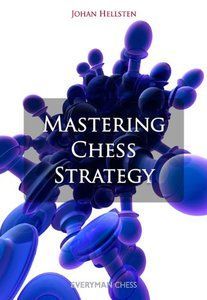Mastering Opening Strategy
Johan Hellsten

MASTERING OPENING STRATEGY by Swedish Grandmaster Johan Hellsten is not the book for those looking for the latest theory in the Marshall Gambit in the Ruy Lopez or for a recent novelty in the Najdorf variation of the Sicilian. Instead it is an instructional manual for better understanding opening principles.
Following in the steps of his well-received middlegame primer MASTERING CHESS STRATEGY, Hellsten uses over 200 examples and model games to illustrate the principles he wishes to convey. Each chapter in Mastering Opening Strategy follows a familiar pattern with a topic first introduced, then illuminated, by well-chosen and carefully annotated games. The student is then given a series of exercises to solve that test their mastery of the subject matter. Detailed solutions reinforce the learning process.
The material covered is as follows:
The Nature of Development 9
Introduction 9
The king and other weak points 10
Pawn advances 16
Causes of a delayed development 22
The development factor after mutual castling 36
A defenders perspective 41
Exercises 47
Solutions 70
2 Crime and Punishment 90
Introduction 90
Early pawn-grabbing 91
Early queen raids 96
Multiple moves with the same piece 100
Exposure of the king 105
Premature attacks 110
Extravagance 113
Ignorance and indifference 119
Exercises 129
Solutions 149
3 The Battle for the Center 166
Introduction 166
Pawn center 166
Centre controlled by a piece 180
Centre controlled at distance 198
Pawn breaks 210
Flank advances 217
The role of the center 224
Exercises 235
Solutions 257
4 Restriction 286
Introduction 286
Restriction of castling 286
Restriction of specific pieces 296
More restriction methods 303
Restriction of plans 310
Exercises 317
Solutions 331
5 A Few Words on Opening Preparation 347
Building an opening repertoire 347
Plans, set-ups, guidelines and move orders 350
Maintaining your repertoire 352
Preparing for your opponents 353
Index of players 355
Index of openings 364
When one discusses the need to develop ones pieces it might sound like beginners talk, but Hellsten repeatedly points out how some of the very best players in the world routinely walk a thin line between getting their pieces out and neglecting development in the pursuit of some other advantage(s) be it material, positional or both.
The first example in the book, Carlsen-Dolmatov, Moscow 2004, played when Magnus was still a young lad, is a perfect example of how easy it is for a strong and experienced Grandmaster to go astray. Here is a portion of this game which is annotated in its entirety.
Throughout the book we will see many positions where a lead in development has to be exploited by concrete means; i.e. by tactical blows, sacrifices etc. Here is a first case:
1.Nf3 f5 2.d3 d6 3.e4 e5 4.Nc3 Nc6 5.exf5 Bxf5 6.d4 Nxd4 7.Nxd4 exd4 8.Qxd4 Nf6 9.Bc4 c6 10.Bg5 b5 11.Bb3 Be7 12.0-0-0 Qd7 13.Rhe1 Kd8 14.Rxe7!
Initiating a decisive combination towards the king on d8. In positions with unbalanced development we should get used to considering the relative value of the pieces. The bishop on e7 is Blacks key defender, covering vital squares such as d6 and f6. Conversely, White has so many pieces in action that losing one of them, even one having a greater nominal value than the enemy piece being captured, isnt really a big deal. With such rooks on a8 on h8, how is Black supposed to save his king?
14…Qxe7
Or 14…Kxe7 15 Bxf6+ gxf6 16 Re1+ followed by 17 Qxf6+.
15.Qf4! Bd7 16.Ne4!
Intensifying the attack. In contrast, 16 Rxd6?! Kc8 lets Black hang on for a while.
16…d5
Or 16…Rf8 17 Nxd6 with ideas like Qb4- a5+. With such an exposed king Black can hardly resist the attack.
17.Nxf6 h6 18.Bh4 g5 19.Qd4!, 1-0.
A nice final touch directed at the rook on h8. Now if 19…gxh4, then 20.Nxd5 cxd5 21.Qxh8+, while other 20th moves run into 21.Nf6, in both cases with an easy win for White. Not much better is 19…Rf8 20.Nxd7 Qxd7 21.Bg3 with an overwhelming advantage, so Black resigned.
MASTERING OPENING STRATEGY should enjoy a wide audience. Players from 1600-2200 will find it a first rate guide to learning intermediate and advanced opening principles and ideas, while teachers will find it offers a wealth of training material. A third group, those who simply enjoy playing through high quality comments (predominately prose) on instructive modern games, will also find what they are looking for.
Highly Recommended.
